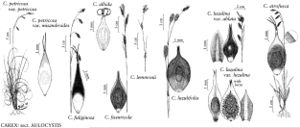Carex fissuricola
Muhlenbergia 5: 53. 1909.
Plants densely or loosely cespitose; rhizomes thick, short. Culms to 80 cm. Leaves: blades 3–8 mm wide. Inflorescences with 3–5 spikes; peduncles of proximal spikes exserted more than 1 cm; proximal bracts with blade (10–) 15–50 mm, sheaths cylindric to ± expanded to mouth, 20–37 mm, mouth with narrow, ± purple band at top, usually Y- or V-shaped, mouth 0.7–1.8 mm wide. Lateral spikes pistillate or often androgynous, purple to brown, proximal spikes pendent to erect, 14–25 × 4–7 mm. Terminal spike staminate or androgynous, ± erect, 10–21 × 4.5–6 mm. Pistillate scales purple or brown with pale, usually indistinctly veined, ovate to elliptic, 2.3–3.8 × 0.8–1.7 mm, midvein and margins ciliate, apex obtuse to short-awned. Staminate scales purple or reddish brown with pale midvein, ovate to obovate, 3–4.4 × 1–1.4 mm, margins slightly ciliate, apex obtuse. Anthers 1.5–3 mm. Perigynia ascending, usually purple or red-brown, veins usually indistinct, ovate to elliptic, 3.2–5.5 × 0.9–1.7(–2) mm, margins flat, less than 1/2 mature achene width, margins setose-ciliate distally, usually at least sparsely hispidulous to shortly setose; beak ± distinct, apex brown to purple, setose-ciliate, distance from beak tip to achene apex usually more than 2 mm. Achenes obovoid, body 1.5–2 × 0.8–1 mm.
Phenology: Fruiting summer.
Habitat: Meadows, rocky stream banks
Elevation: 1500–3500 m
Distribution

Calif., Idaho, Mont., Nev., Utah.
Discussion
Carex fissuricola is intermediate between C. luzulifolia and C. luzulina. A population in Lemhi County, Idaho, has the terminal spike gynecandrous and the perigynium glabrous or subglabrous. It is tentatively included in C. fissuricola.
Selected References
None.
